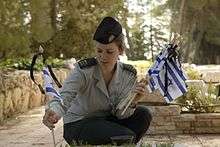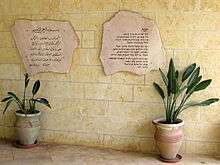Yom Hazikaron
| Yom Hazikaron | |
|---|---|
 IDF soldiers participate in an official Yom Hazikaron ceremony to the fallen soldiers and the victims of terror attacks. | |
| Observed by | Israelis |
| Date | 4 Iyar (Hebrew calendar) |
| 2017 date |
Sunset, 30 April – nightfall, 1 May[1] |
| 2018 date |
Sunset, 17 April – nightfall, 18 April |
| 2019 date |
Sunset, 7 May – nightfall, 8 May |
| 2020 date |
Sunset, 27 April – nightfall, 28 April |
| Related to | Yom Ha'atzmaut |
Yom Hazikaron (Hebrew: יוֹם הַזִּכָּרוֹן; lit. "Memorial Day"), in full Yom Hazikaron l'Chalalei Ma'arachot Yisrael ul'Nifge'ei Pe'ulot Ha'eivah (Hebrew:יוֹם הזִּכָּרוֹן לַחֲלָלֵי מַעֲרָכוֹת יִשְׂרָאֵל וּלְנִפְגְעֵי פְּעוּלוֹת הָאֵיבָה; lit. "Memorial Day for the Fallen Soldiers of Israel and Victims of Terrorism"[2]), is Israel's official remembrance day,[3] enacted into law in 1963.[4] While Yom Hazikaron has been traditionally dedicated to fallen soldiers, commemoration has also been extended to civilian victims of terrorism.[5]
History


In 1949 and 1950, the first two years after the declaration of the State, memorial services for soldiers who fell in the War of Independence were held on Independence Day.[6] Services at military cemeteries were coordinated between the IDF and the Ministry of Defense. A concern arose, expressed by families of fallen soldiers, to establish a separate memorial day observance distinct from the festive celebrations of national independence. In response, and in light of public debate on the issue, Prime Minister David Ben-Gurion – also serving as Minister of Defense – established in January 1951 the "Public Council for Soldiers' Commemoration". This council recommended establishing the 4th of Iyyar, the day preceding Independence Day, as the "General Memorial Day for the Heroes of the War of Independence". This proposal won government approval that same year.[6]
Observance
Yom Hazikaron is the national remembrance day observed in Israel for all Israeli military personnel who lost their lives in the struggle that led to the establishment of the State of Israel and for those who have been killed subsequently while on active duty in Israel's armed forces.[7] As of Yom Hazikaron 2018, that number was 23,645.[8]
Preceding evening
The day opens with a siren the preceding evening at 20:00 (8:00 pm), given that in the Hebrew calendar system, a day begins at sunset. The siren is heard all over the country and lasts for one minute, during which Israelis stop everything, including driving on highways, and stand in silence, commemorating the fallen and showing respect.[7][9]
By law, all places of entertainment are closed on the eve of Yom Hazikaron, and broadcasting and educational bodies note the solemnity of the day.[7] Regular television programs cease for the day, and the names and ranks of every soldier who died for Israel are displayed in a 24-hour television broadcast.[10]
Main memorial day
A two-minute siren is sounded at 11:00 the following morning, which marks the opening of the official memorial ceremonies and private remembrance gatherings at each cemetery where soldiers are buried.[11]
Many Israelis visit the resting places of loved ones throughout the day.[12]
National memorial services are held in the presence of Israel's top leadership and military personnel.[7][9]
Memorial candles are lit in homes, army camps, schools, synagogues, and public places, and flags are lowered to half staff. Throughout the day, serving and retired military personnel serve as honor guards at war memorials throughout the country, and the families of the fallen participate in memorial ceremonies at military cemeteries.[7]
Many traditional and religious Jews say prayers for the souls of the fallen soldiers on Yom Hazikaron. Special prayers prescribed by the Israeli rabbinate are recited. These include the recital of Psalm 9: "For the leader, on the death of the son," and Psalm 144: "Blessed be the Lord, My Rock, who traineth my hands for war and my fingers for battle" in addition to memorial prayers for the dead.[7][13] The official ceremony to mark the opening of the day takes place at the Western Wall.[14]
Channel 33 has screened the names of all civilians killed in pogroms since 1851, and all fallen from 1860 (considered the date of the beginning of the Yishuv by the Israeli Ministry of Defense), in chronological order (rank, name, Hebrew date deceased and secular date) over the course of the day. [15] This has been mentioned in the West Wing episode "Memorial Day".[16] However, it is unknown whether or not this will continue following the replacement of the Israeli Broadcasting Authority by the Israeli Public Broadcasting Corporation.
The day officially draws to a close at sundown (between 19:00 and 20:00; 7–8 p.m.) in a ceremony at the national military cemetery on Mount Herzl, marking the start of Israel Independence Day,[12] when the flag of Israel is returned to full staff.
Scheduling Yom Hazikaron right before Yom Ha-Atzma'ut is intended to remind people of the price paid for independence and of what was achieved with the soldiers' sacrifice.[17] This transition shows the importance of this day among Israelis, most of whom have served in the armed forces, or have a connection with people who were killed during their military service.
Timing
To avoid the possibility of Sabbath desecration should either Yom Hazikaron or Yom Ha'atzma'ut take place on Saturday night, both are observed one or two days earlier (the 3rd and 4th, or the 2nd and 3rd, of Iyar) when the 5th of Iyar falls on a Friday or Saturday (Shabbat). Likewise, when Yom Hazikaron falls on Saturday night/Sunday day, both observances are rescheduled to one day later.[18]
See also
| Wikimedia Commons has media related to Yom Hazikaron. |
References
- ↑ "Dates for Yom Hazikaron". Hebcal.com by Danny Sadinoff and Michael J. Radwin (CC-BY-3.0). Retrieved 2018-08-26 – via Calendar date and Yom Hazikaron.
- ↑ States News Service (24 April 2012). "'We Will Fulfill the Last Will of the Fallen – to Defend Our Home in Israel' (IDF Press Release)". Retrieved 15 April 2013. (subscription)
- ↑ "Yom Hazikaron: Israel's Memorial Day". My Jewish Learning. Retrieved 17 April 2012.
- ↑ "Yom Ha-Zikaron – Israeli Memorial Day". Jewish Virtual Library. 2013. Retrieved 25 April 2012.
- ↑ Haaretz Service; Associated Press (27 April 2009). "Israel honors fallen IDF soldiers, terror victims". Haaretz. Retrieved 15 April 2013.
- 1 2 "Memorial Day for Israel's Fallen Soldiers". Knesset. 2009. Retrieved 25 April 2012.
- 1 2 3 4 5 6 Encyclopedia Judaica, vol. 16, p. 846 (1971)
- ↑ https://www.haaretz.com/israel-news/memorial-day-2018-71-israeli-soldiers-added-to-list-of-fallen-1.5995105
- 1 2 Pelaia, Ariela (19 April 2010). "Yom HaZikaron – Israel Memorial Day". About.com. Archived from the original on 27 April 2012. Retrieved 25 April 2012.
- ↑ http://www.jta.org/2017/04/30/news-opinion/israel-middle-east/israelis-start-memorial-day-with-siren-to-remember-23544-fallen
- ↑ "23,477 fallen remembered in ceremonies across Israel; siren to sound at 11". The Jerusalem Post | JPost.com. Retrieved 11 May 2016.
- 1 2 "Siren Ushers in Israel's Memorial Day". Jewish Telegraphic Agency. 24 April 2012. Retrieved 25 April 2012.
...culminating with a torch-lighting ceremony on Mount Herzl at 8 p.m., which ushers in Yom Ha'atzmaut
- ↑ "Some members of the religious Zionist (national religious) community has [sic] also added special prayers to the prayer service for the evening prayers on Yom Ha-Zikaron." Jewish Virtual Library, op. cit.
- ↑ "Yom Hazikaron (Memorial Day) 2012 in Jerusalem". Go Jerusalem. 2012. Retrieved 25 April 2012.
- ↑ "2015 Memorial Day post". Official Facebook page of the former Israeli Broadcasting Authority.
- ↑ "The West Wing's Leo McGarry on Israel's Memorial Day". YouTube.
- ↑ "About Yom HaZikaron". Israel Ministry of Tourism. 2011. Retrieved 25 April 2012.
...the practice of commemorating the fallen on this day started in 1951 to mark the connection between Independence Day and the people who died to achieve and maintain this independence.
- ↑ Sabag, Asher (2007). "Parshat Yom Ha'atzma'ut". Archived from the original on 12 June 2011. Retrieved 15 April 2013.